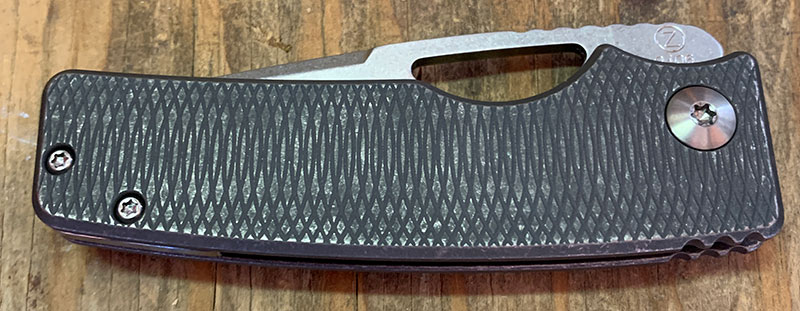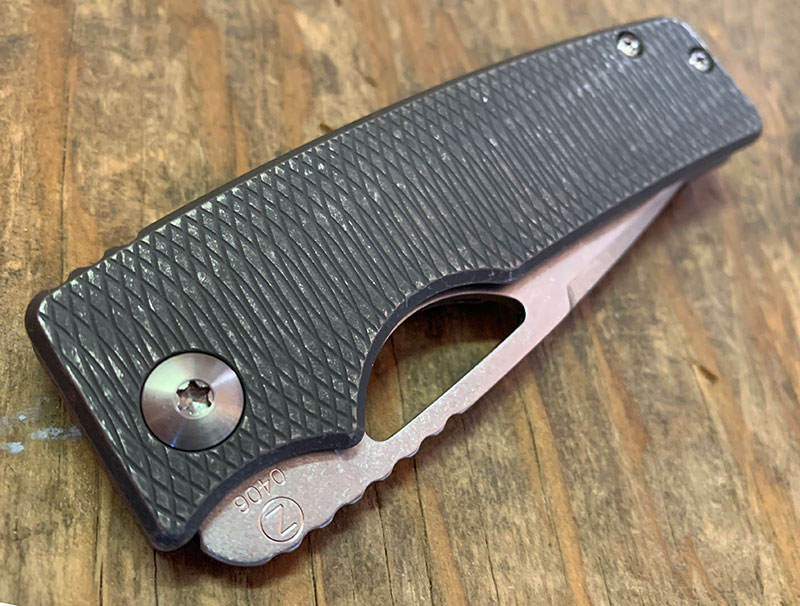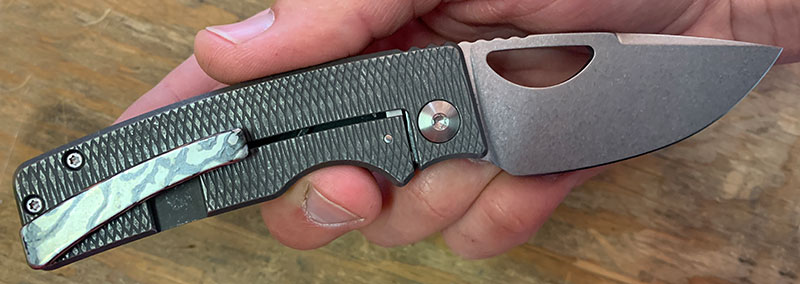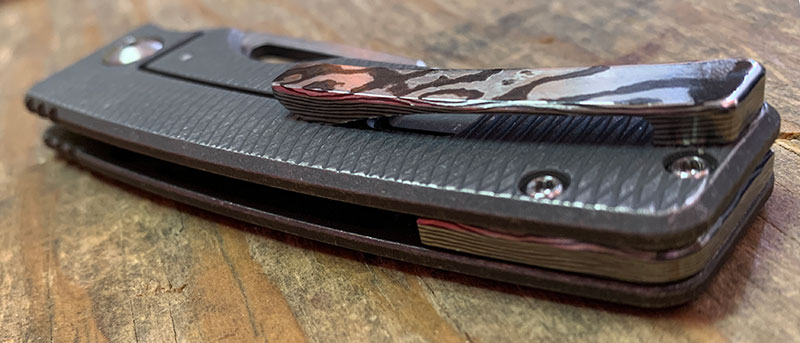We independently evaluate all recommended products and services. Any products or services put forward appear in no particular order. If you click on links we provide, we may receive compensation.

Key Specs: Oz Machine Roosevelt
Blade
I love when a knife maker puts a lot of attention on their blade. It is, of course, the most important part of the tool, and it’s original founding purpose and reason for existing in the first place. And Mr. Oz has done an incredible job making a blade that’s meant to cut. That may sound sarcastic, but it’s not meant to be. There are so many folding knife makers who don’t put an emphasis into the cutting purpose of their knives. They tout “hard use”, which is fair, and some knives do a better job at prying and stabbing tough materials than they do with cutting. But, with a 3” Z-Finit (AKA LC200N steel) blade, a small, comfortable Titanium handle, and a 3 ounce weight, this knife is quite obviously meant for cutting and slicing tasks. But there’s a lot more to the blade than it’s steel composition and an oval-ish hole, so let’s talk about those details that separates this knife from many others.

The jimping on the back of the blade is subtle, as expected, and matches the overall feel and style of the knife. It also lines up with the jimping on the top of the handle scale quite perfectly as well, keeping the theme of detail oriented machining and care. Working down to the opening hole, the level of care continues with an oblong cutout that’s both chamfered and polished. There are some companies (Spyderco, Taichung plant, we’re looking at you here) that are famous for leaving their opening holes not only unpolished, but quite literally sharp around the edges. The Oz boys have made this small spot on the blade so comfortable to use, you’d never notice it. And that’s exactly what they wanted. It just works.
The rustproof Z-Finit blade steel is heat treated by Peter’s, which basically means it’ll be done perfectly (60-61 HRC for this particular steel composition). Strider Knives, and many other small batch knife makers use Peter’s as well, for good reason. They make it easy, and do a great job. Coupled with a full flat grind, and a blade height of approximately 1 ¼” tall, this blade looks and works just like you’d hope. It also allows the edge to be very thin, without a fat shoulder to hinder cutting. The blade has a small swedge at the spine, to give the tip some piercing benefits if needed to the user. Oz also puts the sequential serial number of the knife on the blade, which is hidden when deployed open, but shows with the blade is closed, just next to the small “Oz” logo. It’s a great touch, that allows both the maker and user / buyer to know when the knife was produced, and gives some identification to it.
Deployment / Lockup
A tight, snappy detent is a thing of beauty for a true knife connoisseur. The way a blade snaps back to its closed position is so satisfying and can be a reflection of an overall means of quality judgement on a folder. And the Rosie (Roosevelt) is done perfectly. It allows the blade to be flicked open either in the reverse (Spydieflick) method, or by a standard, boring thumb flick or roll. Coming in to play in deployment is the aforementioned polished and chamfered opening hole. It’s so easy and fun to flick open, and repeated use is a non issue with all the smoothed areas in the right places.

A nice, smooth movement from closed to open is enhanced by the steel bearing pivot system utilized in the Rosie. One aspect I’d like to see improvement on in the pivot would be ceramic bearings. I can’t imagine them upping the price much from the base $500 price tag to make much of a difference. And with a knife that’s quite obviously meant to be a fidgety pocket tool, it feels like a miss from the maker in this one aspect. The steel bearings are still smooth enough to flick open and nearly drop shut, and I do have to admit I appreciate a blade that doesn’t fall shut so fast that it is annoying and semi-dangerous. But to make the knife completely titanium and other rust-resistant steels and alloys, why not choose to use ceramic bearings to complete the knife’s claim of being nearly rust proof? Or switch to phosphor bronze washers? Here I go again, suggesting washers over bearings…. I know it’s not everyone’s preference, but I just like washers better.

Once the blade meets the stop pin, it’s locked open quite rigidly. I always check for any side-to-side, and up-and-down blade play in folders, with some force by hand to get a feel for the level of lockup quality. The Rosie passes all tests in this manner with flying colors. Lockup is strong and solid, with no movement in any direction. Another aspect I really enjoy on a folder that locks up with authority is the lack of lock stick. And this knife is a prime example. There is no feel of any binding or scratching when unlocking the blade. It feels just as you’d hope, smooth, easy, and quick.
Features, Fit and Finish
To break down our review unit anatomically, we have a Z-Finit blade, titanium scales with pattern milling, internal milling of the scales for weight reduction, a Zircuti pocket clip and back spacer, steel bearing pivot system, and a dual ceramic ball detent with an AEB-L lock bar insert. To discuss some of the details of these features, I’d like to start with the detent and lockup. Yes, we just previously discussed these two factors, but I’d like to appreciate them in further detail. The double ceramic detent ball is executed in a very interesting way, that aligns the two detent balls directly side by side within the hardened AEB-L lock bar insert. Then, as the double square shaped detent cutouts in the blade begin to move out of the closed position, the detent balls are situated in such a precise way that they do not interfere with either of the two cutouts in the blade.

With the knife disassembled, this geometric purposeful anomaly can be fully appreciated by means of only a T8 and T25 torx bit to break the knife down. And, to complete the dual purpose, dual ceramic ball detent, is the use of them as the lock interface with the blade tang. As an ode to sir Chris Reeve, the ceramic detent ball lockup pioneer (and Reeve Integral Lock pioneer), Oz’s knife uses this ingenious method of keeping the blade locked open. This method of lockup allows for the super smooth deployment, smooth release of the lock bar from the blade, and extremely long life to the lock interface. And, to compliment that everlasting lock life, is the fact that the ceramic balls are staked in place inside a hardened piece of steel rather than into the raw titanium. Now that’s an impressive feat of machinery, technology and engineering evolution.
Moving on to the Zircuti pocket clip and backspacer, an alloy of titanium and zirconium, is the little bit of pop, or flair added to our particular Rosie. Our unit #0406 has a zircuti pattern that’s mostly a black and white swirl, that gives the raw titanium some contrast in a simple, artistic way. The pocket clip is also internally screwed in, from the inside of the scales, for a clean, simple look that matches the overall style of the knife. And, to add one more layer of detail to the clip, there are two metal dowels that keep the clip pinned in place so that it doesn’t twist from side to side in carry and use, or mark up the titanium handle scales. For a small batch, small team, high precision knife company, a $500 base price starts to sound like a bargain once all the materials and machining come together to form the Roosevelt. Our model was an additional $50 with the scale milling, and an additional $200 for the zircuti parts, totaling $750.

The fit and finish of this knife is on par with it’s price point. Screws have a tight fit and fine threads. Mr. Osborne does show on his website that “all hardware and pivot screws are titanium, and are supplied by TiConnector”. It is nice to know the source of the hardware used, even if it isn’t in-house production, because a lot of the time a manufacturer or knife maker will completely ignore the source of their hardware or even the composition of it. Moving on to the milling, chamfering, and finishing. It’s just so good. To have such a smooth feel of titanium with milling on it, the zircuti clip and backspacer feeling slick to the touch, feeling no gaps, all mating parts fitting seamlessly, it all comes together to form a solid, simple folder that boasts quality and integrity from the maker.
Field Test
I’ve carried and used many, many high end folders. And I had no doubt that this Roosevelt would hold up to any easy to moderate real life use I could put it through. But this knife gave me some real hesitation, not wanting to scratch or ding such a small masterpiece. It shouldn’t be a big deal, with knives like CRK’s and others ranging into the $500-$600 range, but this one felt like it was afraid of use. But, that’s what we do here in the field test.

To cut up an apple is to test a few aspects of a folder in one easy setting. You get a test of the factory edge, the blade geometry, and the ergonomics all in just a couple minutes. The factory edge on the Rosie is incredible. It’s much closer to a hand sharpened edge with a nice polish on it. It’s shaving sharp, and without the typical belt chatter found on common production knives. The blade slices very easily, very cleanly, and is just long enough for simple kitchen tasks like this. And, with the Z-Finit blade steel, there’s no worry of corrosion or patina to develop on the blade, even if it were put away without wiping it down.
Moving out to the garage, some 3/8” twisted sisal rope is awaiting it’s untimely demise. This poor spool of rope never got to fulfill it’s original purpose in life, but rather has been sitting at my work bench for blade testing over and over for years. A few bites into the rope with the Rosie is all it took to convince me that this knife was sharpened and ground for real cutting. It may sound surprising, but probably more than half of the knives I test on this rope fail. And I mean can’t cut through it no matter how much sawing motion I use or how hard I push. No Chris Reeve knife, no Hinderer, and many other big name brands have failed this test with their out-of-the-box edge. Proceeding to cut up the few boxes I was able to save from the recent Amazon cart purchase, I let the Roosevelt shine in glory, slicing and dicing the cardboard panels into small triangles of defeat. It’s such a joy to use a thin ground blade with a nice, sharp edge on a pile of cardboard. It really does feel comparable to using a box cutter, with all the added benefits of the premium materials and ergonomic comforts the Rosie lends.

This knife carries like a dream, too. The clip style and position allow the knife to slide into the pocket easily, yet with enough retention to stay in place and not feel as if it’s going to slip out too easily. With the 3” blade rule of thumb (one ounce of weight for the knife per one inch of blade) is perfectly in proportion here, too. The 3 ounce knife, with only a .38” thick footprint, the Rosie tucks away in the pocket, completing it’s subtle nature even in carry.
Alternatives
All these knives available at BladeHQ.
Spyderco makes so, so many knives. But one of their all-time greats is the Native 5. it’s currently still in production, and has been through tons of variants as they commonly do. The carbon fiber fluted S90V variant is probably the closest variant of the closest style that Spyderco has around that compares with the Oz Roosevelt. Unfortunately, both the Rosie and Native 5 S90V are very difficult to come by, as production on the Spyderco is very limited (if not haulted temporarily), and the Oz is by “books only” (meaning you have to get drawn to win a lottery spot just to pre-order one). Or, be prepared to pay literally double for the Rosie on the secondary market. But I digress, the Native 5 has the same 3” blade length, just under 3 ounces, has a premium stainless steel, but uses a back lock versus the Rosie’s frame lock. But, if you can manage to find one of the Native 5’s in this particular configuration, it’s still about half the price of the Oz ($275 vs the Oz’s $500 base, or $750 in our test unit). There are material differences here, large batch production vs small, hand crafted knives, but there are enough similarities to compare them against each other.
Quiet Carry is a company that’s made quite the name for themselves in the last couple years. And one of their more popular models is the Drift. Using Vanax steel, which is just as rust-proof as the Rosie’s Z-Finit, the Drift has even better edge retention and toughness over the Oz blade. The Drift also uses a 3” blade, a titanium frame lock, a ceramic ball detent, but uses phosphor bronze washers and thumb studs for deployment. Another contender for the every popular “drop” type knives, that come in small batches and sell out immediately. But, with a materials list like this, and a small, simple frame lock pocket knife right at $300, this rust proof folder is a great alternative to the Roosevelt.

Conclusion
If you’re looking for a folding knife that can take place of a fixed blade, look like a stealthy weapon, or take on a backpacking trip, the Oz Machine Roosevelt may not be for you. If you think spending over $150 on a folding knife is absurd, the Rosie is immediately off your radar. If you don’t care what country your pocket knife came from, or what kind of stainless steel the blade is made from, you’re in the wrong isle. But, if you want a premium folder, with artisanal styling and characteristics, made by USA based individuals in a small, detail oriented shop, this is where you’ll find your senses begin to tingle. Your eyebrows will raise. You’ll be surprised with it’s quality even if you’ve seen every YouTube video there is. And you’ll be happy with how it fits the hand and performs in any typical EDC task you’ll ask of it. This one checks all the boxes, even if it demands a price premium and can be a chore to get one in your hands. Just do yourself a favor and don’t pay the scalpers twice the table price on these, together we can cut that nonsense out of the knife community.
- Light, slim, superb fit and finish, high end materials and machining, great for use
- Expensive, difficult to find, not made for harder use
Oz Machine Co Roosevelt
Quality/Performance - 87%
Value for Money - 79%
83%
The Oz Roosevelt checks all the boxes, even if it demands a price premium and can be a chore to get one in your hands





